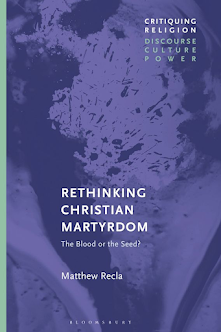Matthew Recla:
Rethinking Christian Martyrdom
The Blood or the Seed?
London: Bloomsbury 2024, 232 pp., index
ISBN 9781350184299
Description
This book argues that we have been mistaken about the fundamental assumption that Christianity is the key to understanding the “Christian” martyr. Examining martyrdom in early Christian history, Matt Recla argues that the violent deaths of martyrs, real and imagined, were appropriated for Christian institutional life. Through deconstructing martyrdom and appreciating the complexity of the martyr, we recognize martyrdom not as a socio-historical phenomenon inherent to particular ideologies, and not as a religious “identity” but as the institutional co-optation of violence. The Christian apologist Tertullian argued that the blood of the martyrs was the seed of the Church, but while the seed may be the key to martyrdom, the blood is the key to the martyr.
The book shows how martyrs exceed the bounds of institutional narrative. Centering analysis of martyrdom first around the martyr’s existential difference and the complex biological, psychological, and socio-cultural factors that lead to willing death, this book sheds new light on the motivations of martyrs, our fascination with them, and the parasitic relationship of religion to violent death.
In challenging long-held beliefs about the praiseworthiness of martyrdom, this book is of interest to scholars of religion as well as those concerned about the relationship between religion and violence (Verlagsinformaion)
Beschreibung
In diesem Buch stellt der Religionswissenschaftler Matthew Recla dar, dass die grundlegende Annahme, das Christentum sei der Schlüssel zum Verständnis des „christlichen“ Märtyrers, ein Irrtum war. Der Autor untersucht das Märtyrertum in der frühen christlichen Geschichte und argumentiert, dass der gewaltsame Tod von Märtyrern, real und imaginär, für das christliche institutionelle Leben genutzt wurde.
Durch die Dekonstruktion des Martyriums und die Würdigung der Komplexität des Märtyrers erkennen wir das Martyrium weder als sozio-historisches Phänomen, das bestimmten Ideologien innewohnt, noch als religiöse „Identität“, sondern als institutionelle Aneignung von Gewalt.
Der christliche Apologet Tertullian legte dar, dass das Blut der Märtyrer die Saat der Kirche sei. Aber während die Saat der Schlüssel zum Martyrium sein mag, ist das Blut der Schlüssel zum Märtyrer.
Das Buch zeigt, wie Märtyrer die Grenzen der institutionellen Erzählung überschreiten.
Indem es die Analyse des Märtyrertums zunächst auf die existenzielle Differenz des Märtyrers und die komplexen biologischen, psychologischen und soziokulturellen Faktoren, die zum freiwilligen Tod führen, konzentriert. So wirft dieses Darstellung ein neues Licht auf die Motivationen der Märtyrer, unsere Faszination für sie und die parasitäre Beziehung zwischen Religion und gewaltsamem Tod. Indem lang gehegte Überzeugungen über die Lobwürdigkeit des Märtyrertums in Frage gestellt werden, kommen hier dekonstruierende Aspekte und Zusammenhänge zur Sprache, die nicht nur für Religionswissenschaftler von Interesse sein dürften, sondern auch für diejenigen, die sich über die Beziehung zwischen Religion und Gewalt Gedanken machen.
Vgl. / see also: Martyrium und (Selbst-)Opfer, [nicht nur] in den Religionen
und nicht nur im Nahen Osten >>>
Author / Autor:
MATTHEW J. RECLA , Associate Director, Boise State University,
Boise, Idaho 83725 – Idaho’s Metropolitan Doctoral Research University (USA)
Details >>>
Table of Contents
Introduction
1. ‚I Need to Watch Things Die‘: Why Martyrdom At All?
Part I: Theories of the Martyr and Martyrdom
2. Autothanatos: The Martyr’s Self-Formation
3. Homo Profanus: Martyrdom as Institutional Violence
4. Blood as Seed: Martyrdom and the Triumph of Christianity
Part II: Martyrdom in Scholarship
5. ‚Voluntary‘ Martyrdom: Avoiding the Stigma of Suicide
6. Scholarship as Ideology: Martyrdom as Christian Identity
7. ‚In Love With Death‘: Revitalizing the Pathological Approach to Martyrdom
Part III: Morality of Martyrdom
8. The Immorality of Martyrdom: Religion and the Manipulation of the Pathological
9. Divine Compulsion: The Autothanatos and the Possibility of Authenticity
Conclusion
10. Blood or Seed?: Martyrdom and the Future of Religion
Bibliography — Index
Deutsche Übersetzung
Einführung
1. „Ich muss die Dinge sterben sehen“: Warum überhaupt Märtyrertum?
Teil I: Theorien über den Märtyrer und das Martyrium
2. Autothanatos: Die Selbstformung des Märtyrers
3. Homo Profanus: Das Martyrium als institutionelle Gewalt
4. Blut als Saatgut: Das Martyrium und der Triumph des Christentums
Teil II: Das Martyrium in der Wissenschaft
5. Das ‚freiwillige‘ Martyrium: Die Vermeidung des Stigmas des Selbstmords
6. Gelehrsamkeit als Ideologie: Märtyrertum als christliche Identität
7. „Verliebt in den Tod“: Die Wiederbelebung des pathologischen Ansatzes zum Martyrium
Teil III: Die Moral des Märtyrertums
8. Die Unmoral des Märtyrertums: Religion und die Manipulation des Pathologischen
9. Göttlicher Zwang: Der Autothanatos und die Möglichkeit der Authentizität
Schlussfolgerung
10. Blut oder Saatgut? Märtyrertum und die Zukunft der Religion
Literaturverzeichnis — Index



